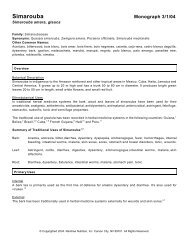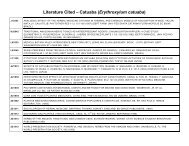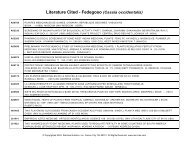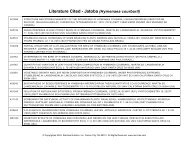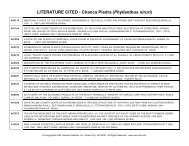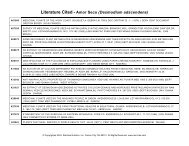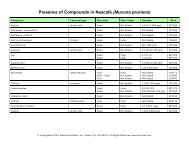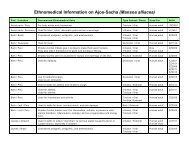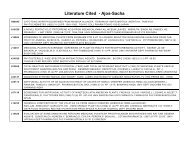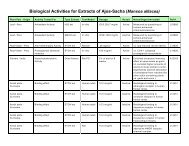Organ Specific Guide - Raintree Nutrition, Inc
Organ Specific Guide - Raintree Nutrition, Inc
Organ Specific Guide - Raintree Nutrition, Inc
You also want an ePaper? Increase the reach of your titles
YUMPU automatically turns print PDFs into web optimized ePapers that Google loves.
AMAZON PANCREAS SUPPORT<br />
Description: A synergistic formula of 6 rainforest botanicals traditionally used by herbal practitioners in<br />
South America for diabetes.<br />
Traditional uses by organ or system: Endocrine: To balance and maintain healthy blood sugar levels.<br />
Ingredients: A proprietary blend of pedra hume caá (Myrcia salicifolia), pata de vaca (Bauhinia forficata),<br />
chanca piedra (Phyllanthus niruri), stevia (Stevia rebaudiana), bitter melon (Momordica charantia), and<br />
neem (Azadirachta indica).<br />
Suggested Use: Take 2-3 capsules twice daily.<br />
Contraindications:<br />
• Not to be used during pregnancy or while breast-feeding.<br />
• This formula contains plants which have demonstrated hypoglycemic actions in animals and/or humans.<br />
Diabetics need to be monitored carefully as antidiabetic medications may need adjustments.<br />
• Those with hypoglycemia should not take this formula.<br />
Drug Interactions: May potentiate antidiabetic medications and insulin. May potentiate hypotensive,<br />
diuretic and hypocholesterolemic medications.<br />
Other Practitioner Observations and Possible Precautions:<br />
• Several plants in this formula have been documented to reduce blood pressure in animal studies.<br />
Individuals with low blood pressure should be monitored for this possible effect.<br />
Synopsis of research: (Please the online Tropical Plant Database for all cited research.)<br />
• Pedra hume caá (called “vegetable insulin” in Brazil) has been documented with hypoglycemic activity<br />
since 1929. Two clinical studies published in the 1990s again demonstrated its hypoglycemic activity and<br />
confirmed its traditional use for diabetes. In a 1990 double-blind placebo clinical study with normal and<br />
Type II diabetic patients, pedra hume caá (3 g powdered leaf daily) demonstrated the ability to lower<br />
plasma insulin levels in the diabetic group. In a 1993 study, 250 mg/kg of a leaf extract demonstrated<br />
the ability to reduce appetite and thirst, and to reduce urine volume, urinary excretion of glucose and<br />
urea in diabetic rats. The extract also inhibited the intestinal absorption of glucose. This study concluded<br />
that "aqueous extracts of Myrcia have a beneficial effect on the diabetic state, mainly by improving<br />
metabolic parameters of glucose homeostasis." In a 1998 study pedra huma caá demonstrated potent<br />
inhibitory activities on aldose reductase and alphaglucosidase.<br />
• Pata de vaca has been demonstrating hypoglycemic and antidiabetic actions in various animal and<br />
human studies since the 1930's. In 2004, a research group reported that pata de vaca again lowered<br />
blood sugar in rats and also reduced triglycerides, total cholesterol and HDL-cholesterol levels in diabetic<br />
rats stating, “These results suggest the validity of the clinical use of B. forficata in the treatment of<br />
Diabetes mellitus type II.”<br />
• In human studies with chanca piedra, researchers reported that blood sugar levels were reduced<br />
significantly in diabetic subjects studied. Two other studies with rabbits and rats document the<br />
hypoglycemic effect of chanca piedra in diabetic animals. Yet another study documented chanca piedra<br />
with aldose reductase inhibition (ARI) properties.<br />
• Scientists tested the hypoglycemic effects of the individual glycoside chemicals in stevia and attributed<br />
the effect on glucose production to the glycosides steviol, isosteviol, and glucosilsteviol.<br />
• To date, close to 100 in vivo studies have demonstrated the hypoglycemic and antidiabetic effects of<br />
bitter melon. This plant has shown the ability to enhance cells' uptake of glucose, to promote insulin<br />
release, and to potentiate the effect of insulin.<br />
• Four clinical studies from 1996 to 2000 document the antihyperglycemic effect of neem. The data<br />
suggests that neem could be of benefit in Diabetes mellitus by controlling blood sugar or may also be<br />
helpful in preventing or delaying the onset of the disease.



